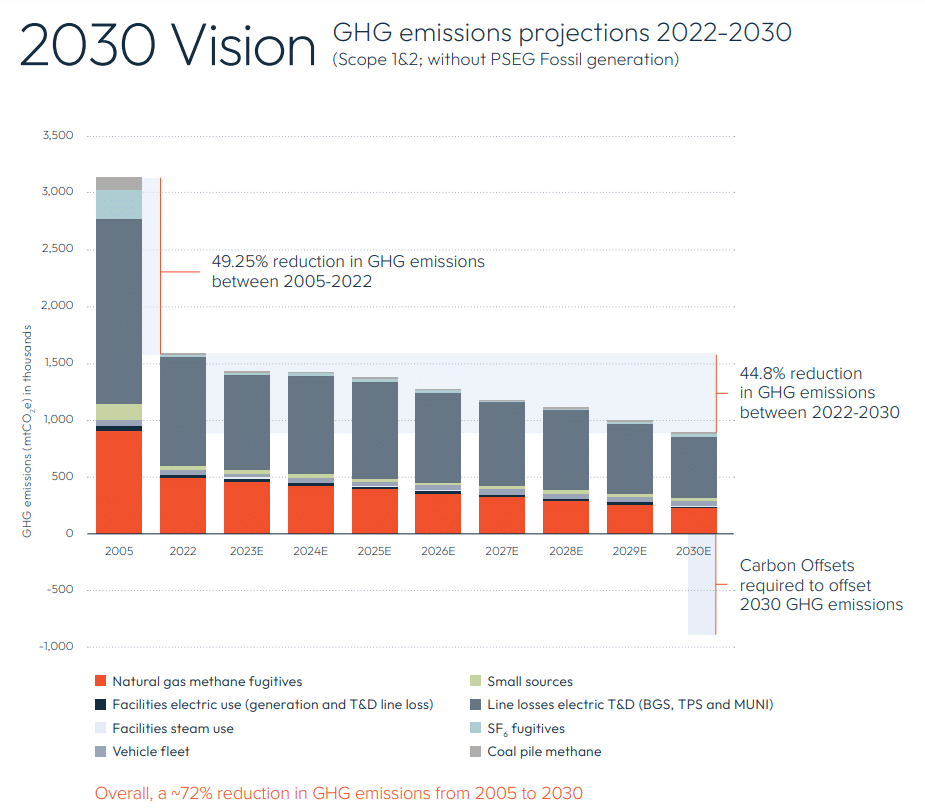Public Service Enterprise Group (PSEG) Inc. has raised its 5-year regulated capital spending plan to potentially reach $21 billion as it focuses on investing in solar, energy efficiency, and grid projects. These investments aim to ensure reliability while striving to achieve the corporation’s net zero goals.
PSEG’s Trailblazing Net Zero Commitment
PSEG’s vision for climate action sets an ambitious net zero goal by 2030. This positions the company as a trailblazer among major utility and power generator firms. This goal comprises three core pillars:
- Net Zero Emissions for PSEG Operations: This encompasses the company’s utility arm, Public Service Electric & Gas, PSE&G’s utility operations (scopes 1 and 2), aiming to achieve net zero greenhouse gas (GHG) emissions by 2030.
- 100% GHG, Carbon-Free Power Generation: PSEG commits to transitioning its power generation to be entirely GHG and carbon-free.
- Contributions to Regional Economy-Wide Decarbonization: PSEG aims to make substantial contributions to broader decarbonization efforts within the regional economy.
PSE&G has already made significant strides in reducing GHG emissions by over 50% from 2005 levels. The group now aims to achieve net zero GHG emissions (scopes 1 and 2) by 2030.
This aim focuses not just on reducing emissions from operations but also addressing GHG emissions associated with natural gas use. It serves about 2 million customers across New Jersey for various crucial needs like space and water heating.
As seen above, the group plans to use carbon offsets to address their 2030 GHG emissions. Carbon offsets are from projects that reduce or remove carbon somewhere else. Each offset equals a tonne of carbon emissions.
New Jersey’s Accelerated Decarbonization Initiatives
In an investor update, PSEG detailed its regulated spending plans for 2024-2028, primarily tied to its utility subsidiary, PSE&G. The company highlighted that these investments are driven by the need for system modernization and align with New Jersey’s decarbonization and energy policy objectives.
In February 2023, New Jersey Governor Phil Murphy announced the state’s ambition to achieve 100% clean electricity by 2035. This goal is accelerated from the initial target of 2050. The state also aimed to electrify 10% of commercial and residential buildings by the end of 2030.
Gov. Murphy further highlighted that:
“These bold targets and carefully crafted initiatives signal our unequivocal commitment to swift and concrete climate action today.”
The current Energy Master Plan (EMP) aimed at achieving the 100% benchmark by 2050, including a goal of 7,500 MW of offshore wind generation by 2035. By July 2022, the state had already exceeded its target of 3.75 GW of new solar generation by 2026. This secures 4 GW of solar power.
The state projects significant savings of $355 million annually and a reduction of 5.5 million metric tons of GHG emissions per year by 2030 through these endeavors and leveraging federal benefits provided by the Inflation Reduction Act.
Additionally, Executive Order No. 317 mandates the New Jersey Board of Public Utilities (BPU) to devise plans for the future of gas utilities in the state. This will align their emissions with the goal of reducing statewide GHG emissions by 50% below 2006 levels by 2030.
Moreover, New Jersey announced initiatives to support the transition to electric vehicles (EVs). The state adopts the Advanced Clean Cars II program and allocates $70 million from its Regional Greenhouse Gas Initiative funds to establish an incentive program for consumers switching to zero-emission vehicles.
As per their 2023 Sustainability Report, PSE&G has installed over 8,000 chargers through their EV Charging Program. The company has invested over $22 million in developing a smart charging infrastructure.
PSEG’s Expanded Clean Energy Capital Plan
Considering these goals and the increased demand for clean energy, electric reliability, and electrification, PSEG’s regulated capital plan saw a rise of over $2 billion, expanding from the earlier $16 billion to $18.5 billion plan for 2023-2027.
The updated plan encompasses a transmission project awarded to PSEG in December 2023 as part of PJM Interconnection’s grid upgrades. The goal is to accommodate data center growth and facilitate power plant retirements.
With that, PSEG’s total capital plan for 2024-2028 now ranges from $19 billion to $22.5 billion. This includes its power supply subsidiary PSEG Power LLC and other investments. The company affirmed that no new equity is needed to support this capital plan.
Moreover, PSEG sustained its 5% to 7% long-term annual earnings growth rate for 2024-2028, coming from its 2024 earnings guidance.
The projected 5-year EPS growth is underpinned by rate base expansion at PSE&G and the production tax credit for its unregulated nuclear fleet. The Inflation Reduction Act’s nuclear production tax credit offers up to $15/MWh for electricity generated by nuclear plants in service in 2024. PSEG Power holds interests in three nuclear plants in the PJM market.
Overall, PSEG’s $21 billion investment for net zero 2030 climate vision stands as a significant and comprehensive step forward in the energy industry. It shows its commitment to combating climate change and fostering a greener and more sustainable industry.


